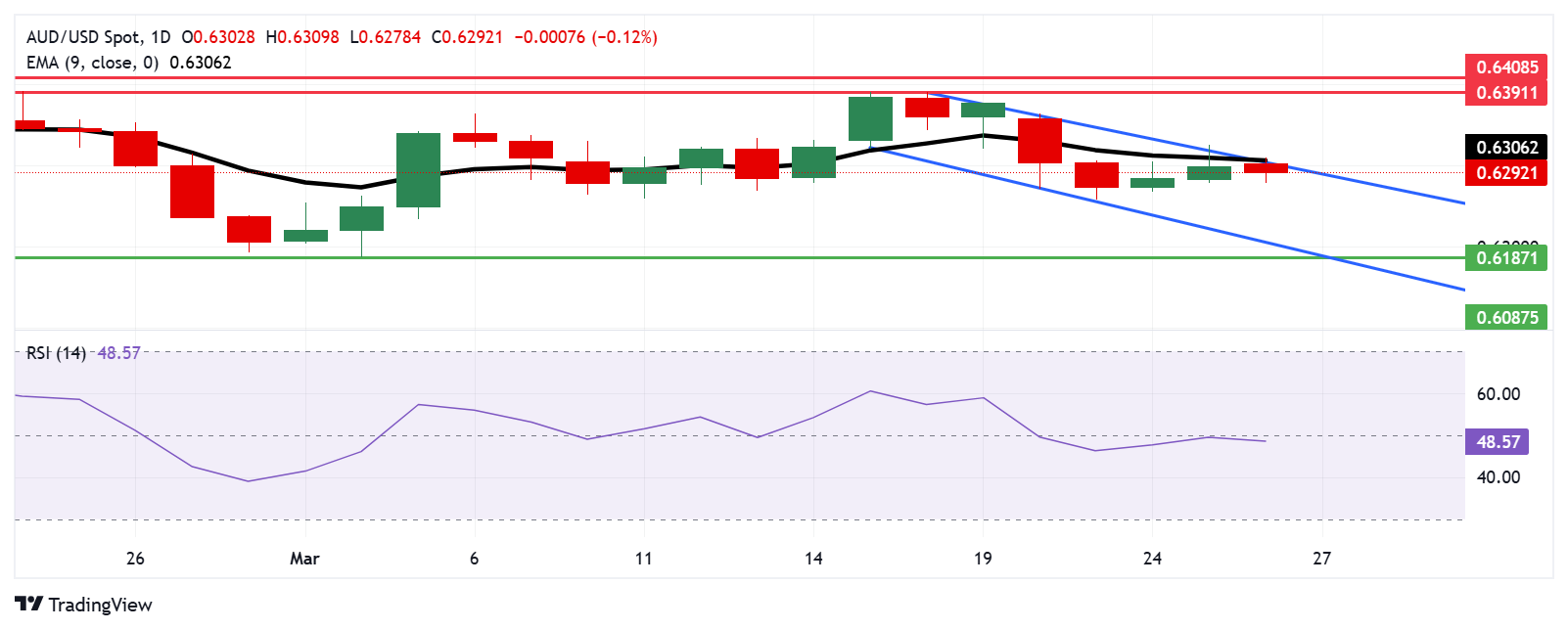- The Australian Dollar rises amid reports that Trump may fast-track the implementation of tariffs on US Copper imports.
- Australian Treasurer Jim Chalmers unveiled the 2025/26 budget on Tuesday, proposing tax cuts totaling around A$17.1 billion over two rounds.
- The US Dollar strengthens as market caution grows ahead of US President Donald Trump's tariff announcement on April 2.
The Australian Dollar (AUD) received support as copper futures surged to a new record high, above $5.20 per pound on the Comex exchange on Wednesday, benefiting from Australia’s position as one of the leading Copper exporters. Bloomberg reported that Trump could accelerate the timeline for imposing tariffs on US copper imports. While the Commerce Department initially had 270 days from February 2025 to investigate and report on potential tariffs, recent developments indicate they could be implemented within weeks, well ahead of the original deadline.
The AUD edged lower against the US Dollar (USD) after Wednesday’s release of the Monthly Consumer Price Index (CPI), which rose 2.4% year-over-year in February, slightly below January’s 2.5% increase and market expectations of 2.5%.
Australian Treasurer Jim Chalmers presented the 2025/26 budget on Tuesday, outlining key economic forecasts and tax cuts totaling approximately A$17.1 billion across two rounds. The budget deficit is projected at A$27.6 billion for 2024-25 and A$42.1 billion for 2025-26. GDP growth is expected to reach 2.25% in the fiscal year 2026 and 2.5% in 2027. The tax cuts appear aimed at strengthening political support.
The AUD finds support as investors anticipate the Reserve Bank of Australia (RBA) will keep interest rates unchanged next week, following its first rate cut of 25 basis points in four years this past February. RBA Assistant Governor (Economic) Sarah Hunter reaffirmed the central bank’s cautious stance on further cuts, with February’s policy statement signaling a more conservative approach than market expectations, particularly regarding US policy decisions and their impact on Australia’s inflation outlook.
Additionally, expectations of Chinese stimulus could boost the Australian economy, given strong trade ties between the two nations. China’s Communist Party and State Council have proposed measures to "vigorously boost consumption" by raising wages and easing financial burdens—an effort to restore consumer confidence and revitalize the struggling economy.
Australian Dollar could struggle as US Dollar gains support amid market caution
- The US Dollar Index (DXY), which tracks the USD against six major currencies, retraces its recent losses from the previous session and is trading around 104.30. The US Dollar gains support as market caution rises ahead of US President Donald Trump's tariff announcement on April 2. While Trump suggested that "a lot" of countries could receive exemptions, the specifics of his administration’s tariff strategy remain uncertain.
- On Wednesday, the Toronto Star cited sources indicating that Canada might face lower-end tariffs in the upcoming measures. However, nothing is guaranteed. Trump is reportedly considering three escalating tariff levels, though some sources suggest this tiered approach is not officially on the table. Nonetheless, it aligns with the government’s expectations for what may unfold next week.
- The S&P Global reported on Monday that the US Composite PMI climbed to 53.5 in March, up from February's 10-month low of 51.6, signaling the strongest growth since December 2024. Services PMI surged to 54.3 in March, a three-month high, from 51.0 in February. Meanwhile, the Manufacturing PMI dropped to 49.8 from 52.7, falling short of market expectations of 51.8.
- Federal Reserve (Fed) Governor Adriana Kugler stated on Tuesday that the central bank’s interest rate policy remains restrictive and appropriately positioned. However, she acknowledged that progress toward the 2% inflation target has slowed since last summer and described the recent rise in goods inflation as "unhelpful."
- Atlanta Fed President Raphael Bostic emphasized ongoing uncertainty on Monday, stating that inflation progress may be slower than previously projected. Bostic trimmed his 2025 rate cut expectations, citing persistent price pressure and trade-related risks.
- On Monday, Australia’s Judo Bank Manufacturing PMI climbed to 52.6 in March from 50.4 in February, while the Services PMI improved to 51.2 from 50.8. The Composite PMI also increased, reaching 51.3 in March compared to 50.6 previously.
Australian Dollar pulls back from 0.6300 barrier near nine-day EMA
The AUD/USD pair is trading near 0.6280 on Wednesday, with technical indicators signaling a bearish bias as the pair consolidates within a descending channel. The 14-day Relative Strength Index (RSI) remains slightly below 50, reinforcing the persistent downward momentum.
On the downside, the AUD/USD pair could navigate the region around the lower boundary of the descending channel at 0.6210, followed by the seven-week low of 0.6187, recorded on March 5.
The nine-day Exponential Moving Average (EMA) at 0.6306, aligned with the descending channel’s upper boundary, acts as the immediate barrier. A breakout above this crucial resistance zone could weaken the bearish bias, with the pair potentially testing the monthly high at 0.6391, which reached March 18.
AUD/USD: Daily Chart
Australian Dollar PRICE Today
The table below shows the percentage change of Australian Dollar (AUD) against listed major currencies today. Australian Dollar was the strongest against the Japanese Yen.
| USD | EUR | GBP | JPY | CAD | AUD | NZD | CHF | |
|---|---|---|---|---|---|---|---|---|
| USD | 0.07% | 0.10% | 0.39% | -0.00% | -0.07% | -0.20% | 0.11% | |
| EUR | -0.07% | 0.02% | 0.29% | -0.08% | -0.13% | -0.28% | 0.03% | |
| GBP | -0.10% | -0.02% | 0.29% | -0.10% | -0.15% | -0.32% | 0.04% | |
| JPY | -0.39% | -0.29% | -0.29% | -0.39% | -0.48% | -0.60% | -0.27% | |
| CAD | 0.00% | 0.08% | 0.10% | 0.39% | -0.04% | -0.20% | 0.14% | |
| AUD | 0.07% | 0.13% | 0.15% | 0.48% | 0.04% | -0.14% | 0.19% | |
| NZD | 0.20% | 0.28% | 0.32% | 0.60% | 0.20% | 0.14% | 0.33% | |
| CHF | -0.11% | -0.03% | -0.04% | 0.27% | -0.14% | -0.19% | -0.33% |
The heat map shows percentage changes of major currencies against each other. The base currency is picked from the left column, while the quote currency is picked from the top row. For example, if you pick the Australian Dollar from the left column and move along the horizontal line to the US Dollar, the percentage change displayed in the box will represent AUD (base)/USD (quote).
Australian Dollar FAQs
One of the most significant factors for the Australian Dollar (AUD) is the level of interest rates set by the Reserve Bank of Australia (RBA). Because Australia is a resource-rich country another key driver is the price of its biggest export, Iron Ore. The health of the Chinese economy, its largest trading partner, is a factor, as well as inflation in Australia, its growth rate and Trade Balance. Market sentiment – whether investors are taking on more risky assets (risk-on) or seeking safe-havens (risk-off) – is also a factor, with risk-on positive for AUD.
The Reserve Bank of Australia (RBA) influences the Australian Dollar (AUD) by setting the level of interest rates that Australian banks can lend to each other. This influences the level of interest rates in the economy as a whole. The main goal of the RBA is to maintain a stable inflation rate of 2-3% by adjusting interest rates up or down. Relatively high interest rates compared to other major central banks support the AUD, and the opposite for relatively low. The RBA can also use quantitative easing and tightening to influence credit conditions, with the former AUD-negative and the latter AUD-positive.
China is Australia’s largest trading partner so the health of the Chinese economy is a major influence on the value of the Australian Dollar (AUD). When the Chinese economy is doing well it purchases more raw materials, goods and services from Australia, lifting demand for the AUD, and pushing up its value. The opposite is the case when the Chinese economy is not growing as fast as expected. Positive or negative surprises in Chinese growth data, therefore, often have a direct impact on the Australian Dollar and its pairs.
Iron Ore is Australia’s largest export, accounting for $118 billion a year according to data from 2021, with China as its primary destination. The price of Iron Ore, therefore, can be a driver of the Australian Dollar. Generally, if the price of Iron Ore rises, AUD also goes up, as aggregate demand for the currency increases. The opposite is the case if the price of Iron Ore falls. Higher Iron Ore prices also tend to result in a greater likelihood of a positive Trade Balance for Australia, which is also positive of the AUD.
The Trade Balance, which is the difference between what a country earns from its exports versus what it pays for its imports, is another factor that can influence the value of the Australian Dollar. If Australia produces highly sought after exports, then its currency will gain in value purely from the surplus demand created from foreign buyers seeking to purchase its exports versus what it spends to purchase imports. Therefore, a positive net Trade Balance strengthens the AUD, with the opposite effect if the Trade Balance is negative.
Information on these pages contains forward-looking statements that involve risks and uncertainties. Markets and instruments profiled on this page are for informational purposes only and should not in any way come across as a recommendation to buy or sell in these assets. You should do your own thorough research before making any investment decisions. FXStreet does not in any way guarantee that this information is free from mistakes, errors, or material misstatements. It also does not guarantee that this information is of a timely nature. Investing in Open Markets involves a great deal of risk, including the loss of all or a portion of your investment, as well as emotional distress. All risks, losses and costs associated with investing, including total loss of principal, are your responsibility. The views and opinions expressed in this article are those of the authors and do not necessarily reflect the official policy or position of FXStreet nor its advertisers. The author will not be held responsible for information that is found at the end of links posted on this page.
If not otherwise explicitly mentioned in the body of the article, at the time of writing, the author has no position in any stock mentioned in this article and no business relationship with any company mentioned. The author has not received compensation for writing this article, other than from FXStreet.
FXStreet and the author do not provide personalized recommendations. The author makes no representations as to the accuracy, completeness, or suitability of this information. FXStreet and the author will not be liable for any errors, omissions or any losses, injuries or damages arising from this information and its display or use. Errors and omissions excepted.
The author and FXStreet are not registered investment advisors and nothing in this article is intended to be investment advice.
Recommended content
Editors’ Picks

Gold falls amid a possible de-escalation of US-China tensions Premium
Gold pulled back from its all-time high of $3,500 per troy ounce reached earlier on Tuesday, as a resurgent US Dollar and signs of easing tensions in the US–China trade dispute appeared to draw sellers back into the market.

EUR/USD tumbles to near 1.1350 on renewed US Dollar demand
The EUR/USD pair attracts some sellers to around 1.1355 during the early Asian session on Wednesday, pressured by the renewed US Dollar demand. The Greenback recovers after US President Donald Trump said he had no intention of firing Federal Reserve Chair Jerome Powell despite his frustration with the central bank not moving more quickly to slash interest rates.

GBP/USD deflates to weekly lows near 1.3350
GBP/USD loses further momentum and recedes to the 1.3350 zone on Tuesday, or two-day troughs, all in response to the frmer tone in the US Dollar and encouraging news from the US-China trade scenario.

Ethereum rallies 10% amid decline in CME short positions
Ethereum saw a 10% gain on Tuesday after the general crypto market rallied alongside Bitcoin. The rally comes after the ETH Chicago Mercantile Exchange basis plunged from 20% in November to about 5% in April.

Five fundamentals for the week: Traders confront the trade war, important surveys, key Fed speech Premium
Will the US strike a trade deal with Japan? That would be positive progress. However, recent developments are not that positive, and there's only one certainty: headlines will dominate markets. Fresh US economic data is also of interest.

The Best brokers to trade EUR/USD
SPONSORED Discover the top brokers for trading EUR/USD in 2025. Our list features brokers with competitive spreads, fast execution, and powerful platforms. Whether you're a beginner or an expert, find the right partner to navigate the dynamic Forex market.




